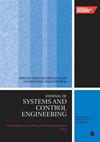Compensation of friction and stick-slip uncertainties in trajectory tracking control of servo DC machines considering actuation constraints
IF 1.4
4区 计算机科学
Q4 AUTOMATION & CONTROL SYSTEMS
Proceedings of the Institution of Mechanical Engineers, Part I: Journal of Systems and Control Engineering
Pub Date : 2023-10-04
DOI:10.1177/09596518231196830
引用次数: 0
Abstract
Nowadays, electric motors are common in many precision instrument industries that require high-precision control. If a suitable model of a servo system is available, accurate results can be obtained using a model-based control algorithm. The DC motor is one of the most widely used systems in precision industries, for which a high-precision controller can be designed using its mathematical model with feedback on position and velocity. In such systems and other rotating systems, it is necessary to consider friction in the control system design. Friction enters the system in the form of resistant force or torque in both static and kinetic states, which causes uncertainty in the dynamic modeling of the system, the stick-slip phenomenon, and creates a deadzone in the actuation system. In this article, considering a switching dynamic model for different states of a system subject to friction which has a saturation limit on the control input and an actuation system dependent on the angular velocity feedback, first, the stable reaching laws in two modes of position control and velocity control for different dynamic model switch modes are defined. Then, the control input that forces the tracking error to follow the corresponding reaching law for each control mode is calculated. In the next step, according to the limitations of the actuation system, such as saturation and deadzone, using the filtering mechanism and optimal search for each control mode, the desired values are filtered and it is guaranteed that the control input will be chosen within the allowed range. Finally, using the optimal switching mode selection mechanism, the optimal control mode is selected and the voltage is calculated as the next step input.考虑驱动约束的伺服直流电机轨迹跟踪控制中摩擦和粘滑不确定性补偿
如今,在许多需要高精度控制的精密仪器行业中,电动机是常见的。如果有合适的伺服系统模型,则可以使用基于模型的控制算法获得准确的结果。直流电动机是精密工业中应用最广泛的系统之一,利用其位置和速度反馈的数学模型可以设计高精度控制器。在此类系统和其他旋转系统中,在控制系统设计中必须考虑摩擦。摩擦以静力或扭矩的形式进入系统,造成系统动力学建模的不确定性,产生粘滑现象,并在作动系统中形成死区。本文考虑具有控制输入饱和限制的摩擦系统不同状态切换动态模型和依赖角速度反馈的驱动系统,首先定义了不同动态模型切换模式下位置控制和速度控制两种模式下的稳定到达规律。然后,对每种控制模式计算使跟踪误差服从相应趋近律的控制输入。下一步,根据驱动系统的饱和、死区等限制,利用滤波机制和对各控制方式的最优搜索,对期望值进行滤波,保证控制输入选择在允许范围内。最后,利用最优开关模式选择机制,选择最优控制模式,并计算电压作为下一步输入。
本文章由计算机程序翻译,如有差异,请以英文原文为准。
求助全文
约1分钟内获得全文
求助全文
来源期刊

CiteScore
3.50
自引率
18.80%
发文量
99
审稿时长
4.2 months
期刊介绍:
Systems and control studies provide a unifying framework for a wide range of engineering disciplines and industrial applications. The Journal of Systems and Control Engineering refleSystems and control studies provide a unifying framework for a wide range of engineering disciplines and industrial applications. The Journal of Systems and Control Engineering reflects this diversity by giving prominence to experimental application and industrial studies.
"It is clear from the feedback we receive that the Journal is now recognised as one of the leaders in its field. We are particularly interested in highlighting experimental applications and industrial studies, but also new theoretical developments which are likely to provide the foundation for future applications. In 2009, we launched a new Series of "Forward Look" papers written by leading researchers and practitioners. These short articles are intended to be provocative and help to set the agenda for future developments. We continue to strive for fast decision times and minimum delays in the production processes." Professor Cliff Burrows - University of Bath, UK
This journal is a member of the Committee on Publication Ethics (COPE).cts this diversity by giving prominence to experimental application and industrial studies.
 求助内容:
求助内容: 应助结果提醒方式:
应助结果提醒方式:


